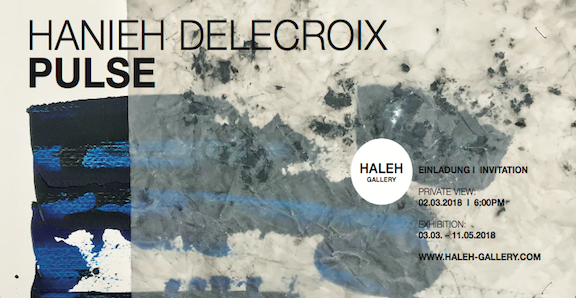PULSE

Press release
In the exhibition PULSE, Haleh Gallery presents an extensive overview of Hanieh Delecroix’s artistic oeuvre from 2011–2017. Hanieh Delecroix’s artistic practice is strongly shaped by her profound knowledge of psychology. In her artistic works psychoanalysis, writing and painting coalesce in a fascinating way. It is specifically this symbiosis that creates mesmerizing images, which the artist produces in different media, such as drawing, text, photography, installation, and video. The artist’s works fall into different categories. The first group includes work concentrating solely on pictorial characteristics of painting and implementing psychological concepts. In her other works, artistic writing plays a major role as a means of expression. The incorporation of scripture opens a space of negotiation to reflect on questions of cultural identity and national origin. On the one hand Hanieh Delecroix deploys text in French language — French as the spoken language of her hometown of Paris and her education. At the same time Delecroix uses Persian script and text referring to her cultural roots in Iran.
Shades of black and blue take centre stage in Delecroix’s works. Different shades of blue, ultramarine, midnight blue, and dark blue are applied with a palette knife creating an abstract expression of forms. Writing — in the artist’s own hand — constitutes an autonomous, artistic pictorial means. The forms produced in combination with the script manifest a magical interplay between text and image.
Delecroix often chooses the fragile material of paper for her works. The specific materiality of paper emerges in its own characteristics — crumpled, torn, transparent, or translucent.
Paper is a fragile, but can also be a dense and tough material. Paper may not only be torn, but may also act as aggressor — inflicting painful paper cuts.
The works on paper are pictorial metaphors of the harmony between mind and body. The scripture functions as a symbol of the human mind, which is often shaped by text and language, written, read, or heard. Through its material characteristics paper eventually adopts the function of human skin. Our skin is the outer reflection of the soul and tells of our wrinkles, injuries, scars, and traces, which life and experiences have left on our bodies.
At the same time, the dualities of blue and black, scripture and paper, text and image also refers to other dialectical opposites, such as subjects and objects, self and other, Eros and
Thanatos. For Sigmund Freud the Greek mythological characters of Eros and Thanatos became the central means to designate the life and death instinct.
The references to Freud and psychoanalysis are a red thread in Delecroix’s artistic practice, which can also be observed in her series “Panser Joyce à mi-maux”. Similar to her series
“Pensées divines”, where Honoré Balzac’s poems constitute Delecroix’s blue-black pictorial worlds, she integrates poems and texts by the French-Egyptian writer Joyce Mansour
(1928-1986) in her images. Joyce Mansour was a surrealist author, whose poems also inspired among others, André Breton. With regard to Surrealism in general, and the writer
Joyce Mansour in particular, Delecroix refers to the artistic expression of Surrealism, which was highly influenced by Freud’s psychoanalysis in order criticize the rationality practiced at the beginning of 20th century and to awaken the power of the subconscious for artistic production.
Psychology plays also a major role in Delecroix’s series “Pensées divines”. This work deals with Honoré de Balzac’s novel “Louis Lambert”, published in 1832. In this novel, Balzac discusses great topics of philosophy and metaphysics. Simultaneously, Balzac prepares a character study and creates a psychological portrait of his protagonist Louis Lambert trapped between genius and madness.
This comes full circle with Hanieh Delecroix’s own words, when she explains: “My works result from the resonance of two worlds: The psyche and artistic writing.” Hanieh Delecroix breathtakingly succeeds to harmonize the dual worlds of mind and writing, body and mind.
CV
Hanieh Delecroix (*1974 in Tehran, Iran) lives and works as an artist in Paris. Graduated in Clinical and Pathological Psychology from University Paris X Nanterre. She holds a doctoral level degree from LASI (Laboratory for Somatic and Identity Issues).
Exhibitions (selection):
Mairie de Paris (Paris City Hall, 2017); Maison de Balzac (2017); Freud Museum, London (2017); “The Writing of Art”, Rose Issa Projects, The Ismaili Center for Nour Festival, London (2016); “Jules César”, Museum Quai Branly, Paris (2015); “Lifeline”, Rose Issa Projects, London and Dubai (2013 and 2014).
Museum acquisitions:
King Abdulaziz Center for World Culture WASL 2018, Dhahran, Saudi Arabia, “A coeur ouvert”, Painting from series “Lifeline”.
British Museum, “Dans ta main”, exhibited in the department for Islamic Art, Painting from series “Lifeline”.
« Back to exhibition overview
